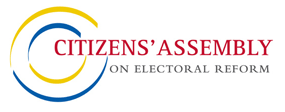The Citizens’ Assembly on Electoral Reform was a
unique initiative. Nowhere else in the world had such power over an
electoral system been given to non-elected citizens.
The premier of B.C., Gordon Campbell, promised in
2001 that, if elected, his government would establish such an
Assembly.
Here’s what happened after that:
-
Sept. 20, 2002: The new provincial government took its
first step towards creating the Citizens’
Assembly on Electoral Reform by appointing Gordon Gibson to develop
recommendations on how the assembly should function and be
structured.
-
December 23, 2002: Gordon Gibson submitted his
Report on
the Constitution of the Citizens' Assembly on Electoral
Reform.
-
April 28, 2003: The government
announced it would introduce a motion in the Legislature to
establish the Assembly. That same day, the government nominated Dr. Jack Blaney
as the chair of the assembly. And Attorney General Geoff Plant
tabled the Assembly’s
Terms
of Reference
and
Duties
of the Chair
.
-
April 29, 2003: The Attorney General gave the required notice of
motion to the Legislature to create the Assembly.
-
April 30, 2003: The Attorney General formally asked the
House to support the creation of the Assembly. The
motion was unanimously
approved. A special
committee of the legislature was set up: Its terms
of reference authorize it to review Assembly staff appointments,
and to receive interim reports from the Assembly chair on the
progress of the Assembly’s work.
-
May 8, 2003: Jack Blaney is confirmed as Chair of the
Citizens’ Assembly.
-
July 4, 2003: Leo Perra is
appointed as Director of Operations for the Assembly.
-
July 2003: Voters List Registration Drive began.
-
July 28, 2003: Ken
Carty was appointed Chief Research Officer for the
Assembly.
-
August 22, 2003: Voters List Registration Drive
concluded.
-
August 29, 2003: Harry Neufeld, Chief Electoral Officer
of Elections BC, delivered to
the Citizens’ Assembly 15,800 randomly selected names
from British Columbia’s voters list. These names formed
the pool of potential members for the member-selection process.
-
September 24, 2003: Marilyn
Jacobson was confirmed Director of Communication and Don MacLachlan
as Associate Director of Communication.
-
October 14, 2003: The first four
members were selected at a meeting in Fort St. John. (Sadly,
one of the four died before taking office, and another
member was drawn in his place.) Another 25 selection meetings
then followed, throughout B.C.
-
November 7, 2003: First meeting of Research Program
Working Group. A group of political scientists and community
advisors met with the Assembly’s research and education
team to provide suggestions on the Assembly’s
phases.
-
November 25, 2003: Five Vancouver members were selected,
bringing the total to 157. Only one member (from
Vancouver-Kingsway) remained to be selected.
-
December 8, 2003: The 158th
member was selected.
-
December 10, 2003: The provincial cabinet approved the
addition of two Aboriginal members, also selected from
the random pool.
-
December 22, 2003: The two Aboriginal
members were selected, bringing the membership to 160. (Dr.
Blaney is the 161st.)
-
January 10-11, 2004: The Assembly began its " Learning
Phase" meetings, six weekends in January-March 2004. Meetings
were held at the Morris J. Wosk Centre for Dialogue, 580 West
Hastings Street, Vancouver, and were open to the public. (For its
subsequent calendar and archive of events, click here.)
-
-
May 3, 2004: The Assembly began, in Vancouver, the
first of 50 open public hearings, in communities large and
small, all over B.C. (Here is the
schedule of the meetings.)
-
June 24, 2004: The Assembly held the
last of its 50 public hearings, in Kelowna.
-
June 26-27, 2004: The Assembly met in
Prince George to review and discuss what members heard from
British Columbians in the hearings and in written submissions, and
to plan their fall sessions. The meeting was open to the
public.
-
July – August 2004: Members took a summer
"reading break", with homework that included some
1,600 written submissions from the public to study.
-
September 11, 2004: The Assembly began its " Deliberation
Phase", six weekends of meetings at the Morris J. Wosk Centre
for Dialogue in Vancouver. Plenary sessions were open to the
public. Nine plenary presentations were made, of the best
presentations made at one of the public hearings.
-
September 27, 2004: The last date for making written submissions
to the Assembly. In all, 1603 submissions were received.
-
October 23, 2004: Assembly members decided that, if they
were to propose a new electoral system to the people of B.C., it
would be a made-in-B.C. Single Transferable Vote (STV) model.
-
October 24, 2004: Members decided to recommend to the voters of
B.C. that they replace the current First Past the Post electoral
system with the Assembly's BC-STV model.
-
November 13-14 and 27-28, 2004: Final meetings of the
Assembly, in Vancouver. On November 27, the members fine-tuned
their BC-STV Recommendation, and drafted their Final Report. And on
November 28 they ended their work, and prepared to disband.
-
December 10, 2004: The
Assembly submitted its final report and recommendation
to the people and government of British Columbia. A supporting Technical
Report, with background documents and detailed explanations of
BC-STV, was issued on 20 December 2004.
Closing phase
Referendum
-
May 17, 2005: B.C.'s voters cast ballots in a referendum on the
Assembly's recommendation, as part of the provincial general
election.
» MORE DETAILS
-
More detail on the Assembly's formation and operation is well
covered in a presentation made by Leo Perra, the
Assembly's chief operations officer, in Beijing. He was speaking
there to the Sino-Canadian Seminar on Public Participation in the
Legislative Process on 13 July 2004. We have online his speech as a
Word document
(100KB) and as a PDF
file (260KB). He also used a PowerPoint
presentation (it's a really big file of 84.2MB).
-
On October 23, 2004, the Assembly announced the first (and only)
resignation of a sitting member, Paola Barakat of Richmond. That
left the membership at 159 plus chair Jack Blaney.
|
Related Information
|
> Gov't announcement (28 April 2003) |
|
> Premier's speech (28 April 2003) |
|
> Gibson background |
 |  | > The Gibson
Report |
 |  | > Government
decisions |
 |  | >
Notice of Motion |
| >
Motion approved |
| >
Terms tabled |
 |  | > Terms
of reference |
 |  | >
Duties of chair |
| > Special
committee |
 |  | > Public
brochure |
 |  | >
Member eligibility |
|
> Cabinet meeting 10 December 2003 (transcript) |
|
> Cabinet meeting 10 December 2003 (webcast) |
| >
Order in Council #1197, 10 December 2003 |
 |  | > Mandate from the
Terms of Reference |
| > Jack Blaney's opening
speech, January 10, 2004 |
 |  | >
Assembly policies and procedures |
 |  | >
Assembly statement of Shared Values |
 |  | > Approved
policy re: presentations to Assembly in plenary |
 |  | >
Record of Proceedings, Jan. 9-11, 2004 |
 |  | >
Record of Proceedings, Jan. 24-25, 2004 |
 |  | >
Record of Proceedings, Feb. 7-8, 2004 |
 |  | > Record
of Proceedings, Feb. 21-22, 2004 |
 |  | >
Record of Proceedings, March 6-7, 2004 |
 |  | > Record of
Proceedings, March 20-21, 2004 |
 |  | >
Preliminary Statement to the People of BC |
 |  | >
Record of Proceedings, 11-12 September 2004 |
 |  | >
Record of Proceedings, 25-26 September 2004 |
 |  | >
Record of Proceedings, 16-17 October 2004 |
|
> Record of Proceedings, 23-24 October 2004 |
|
> Record of Proceedings, 13-14 November 2004 |
 |  | > Record of
Proceedings, 27-28 November 2004 |
|
> Final Report (10 December 2004) |
|
> Final Report (French) |
|
> Final Report (Chinese) |
|
> Final Report (Punjabi) |
 |  | >
Technical Report (20 December 2004) |
|





